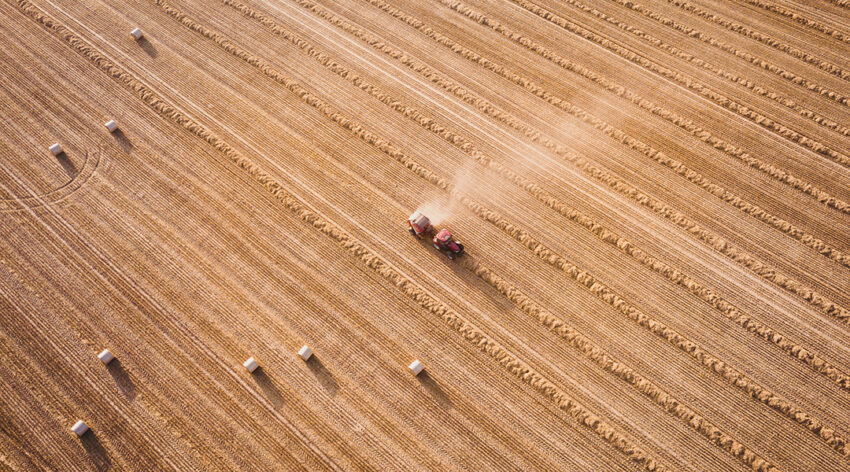As the global push for net-zero emissions intensifies, scientists are turning to agrivoltaics — the combination of agriculture and solar power — as a means to reduce carbon emissions from food production, while optimizing both crop yields and energy generation.
According to a recent report by the Intergovernmental Panel on Climate Change, the agricultural and forestry sectors are the second highest polluters (behind the energy sector), contributing up to 22% of all global CO2 emissions.
“Agrivoltaics are an innovative approach to generating renewable energy that could help decarbonize the agricultural industry, explained Austin Kay at Swansea University. “In essence, agrivoltaics are solar panels (photovoltaics) combined with agricultural settings, allowing the same piece of land to be used for electrical power generation as well as food production/land cultivation.
“This could be as simple as placing traditional photovoltaics, like crystalline-silicon, in fields of livestock, or it could involve more complex approaches, [such as] solar panels placed over fields of crops or protected cropping environments, like greenhouses. and polytunnels.”
Agrivoltaics and net zero
The impact of this approach, even if implemented on a comparably small or local scale, could still be staggering. “Covering just 1% of its current agricultural area with agrivoltaics, the EU could meet its capacity targets for the year 2030 with these devices alone,” said Kay. “Providing locally-generated power in this way, agrivoltaics offer a promising route to decarbonising the agricultural industry; and, if done right, they can be introduced without negatively affecting crop yields.”
But optimizing agrivoltaics is a challenging task that involves finding the right balance between crop yield and generating solar energy. This requires careful attention to how light is absorbed, reflected, or transmitted through the photovoltaic set up, as well as how efficiently the system converts sunlight into electricity, all while managing heat and energy flow.
“[Solar panels] and crops both require light,” added Kay. “Balancing how much of this light used by the photovoltaics and how much is received by the crops is a complex problem that depends on location, time of year, the light requirements of the specific crop, the needs of any insect pollinators like bees, and many [other factors.
“At higher latitudes, [for example], there is typically less light available to the crop throughout the year, and so a higher transmittance of light through the photovoltaics is likely needed. At lower latitudes this is less of a concern as shading effects can be desirable, particularly during the hotter seasons.”
Ironing out the details
Kay and his team of collaborators sought to evaluate the annual power generation of agrivoltaic systems using different types of photovoltaic materials and considering factors, such as density of the solar cells, location, and ideal crop. Their findings provide a foundation for developing larger systems that take into account crop needs and environmental factors, while focusing on energy efficiency and thermodynamic principles.
“We make us of the National Solar Radiation Database (NSRDB) hosted by the National Renewable Energy Laboratory (NREL) to extrapolate results obtained in the laboratory to real-world scenarios,” said Paul Meredith, a co-author on the study. “The NSRDB holds information that is key for determining realistic photovoltaic performance, such as temperature and solar irradiance.”
By combining real-world data on sunlight and temperature with detailed models, they compared the performance of organic semiconductor-based photovoltaics to traditional silicon-based photovoltaics.
Organic photovoltaics are made from organic (meaning carbon-based) compounds and are usually semitransparent, meaning that they can be easily integrated into agrivoltaic systems. Their ability to allow light through makes them ideal for advanced greenhouses, while silicon photovoltaics, though more efficient at converting sunlight into electricity, are opaque and block light, limiting their use in agricultural settings.
There is also the added benefit that the optical properties of organic semiconductor-based photovoltaics can be more easily tailored. “Their optical gaps and transmission properties can be adjusted through their chemical structure, allowing an optimal material to be assigned according to the light requirements of a given crop,” explained Ardalan Armin, the project lead.
“Organic semiconductor-based photovoltaics are also lightweight and flexible, allowing for the retrofitting of older structures and polytunnels, which may not withstand the weight of traditional silicon-based photovoltaics,” he added.
A trade off, but one that could be worth it
Overall, they did find that state-of-the-art, inorganic silicon-based solar panels did generate more power per square meter than their semitransparent organic counterparts, but factors such as their coverage, weight, flexibility, and how efficiently land could be used might allow them to compete with established inorganic systems.
But there is another caveat to explore: how each material is fabricated also requires consideration in the context of sustainability and impact on the environment. “What is the environmental cost of our sources of clean energy?” asked Kay.
The leading photovoltaic material on the market, mono-crystalline silicon solar cells, usually require temperatures in excess of 1000oC during manufacturing. “Silicon photovoltaics therefore have a high embodied energy,” said Kay. “Organic semiconductors and perovskites, on the other hand, can be synthesized from solution at much lower temperatures using techniques like roll-to-roll printing and slot-die coating — similar to newspaper printing. Solution-processible photovoltaics therefore have a much lower embodied energy.”
Kay says that future study could incorporate for the light intensity and wavelength requirements of specific crops. But he predicts that things are already changing.
“Just this year, the efficiency of organic photovoltaics passed 20%, and devices with operational lifetimes of up to 30 years have been fabricated in the past,” he said. “With these continuous improvements and a decrease in organic molecule synthesis and device fabrication costs, we may one day see fewer agrivoltaic projects using traditional silicon photovoltaics, and instead see larger-scale projects using semi-transparent, organic photovoltaics.”
Reference: Austin M. Kay, et al., On the Performance Limits of Agrivoltaics—From Thermodynamic to Geo-Meteorological Considerations, Solar RRL (2024). DOI: 10.1002/solr.202400456
Feature image credit: Ivan Bandura on Unsplash

